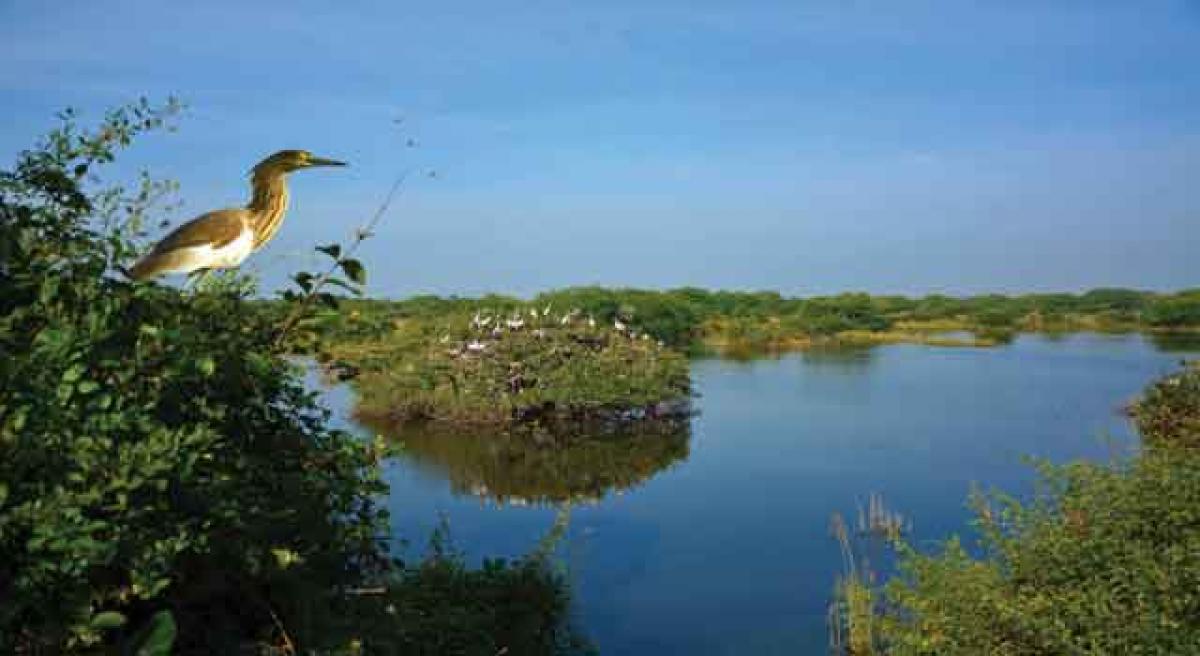Live
- My Dear Donga: trailer get grand launched
- Supreme Court reserves verdict
- Poll battle begins
- Phase 1 polls in 102 seats across 21 states today
- 39 candidates file papers on Day 1
- ED arrests AAP MLA Amanatullah Khan in Waqf Board appointment scam
- LS polls: Union Minister Bhagwanth Khuba, Dingaleshwara seer, Priyanka Jarkiholi file nominations in K'taka
- Amid show of strength, Congress’ Praniti Shinde files nomination from Solapur
- Tamil Nadu Police gives clean report to Isha Foundation in missing volunteers case
- Home Minister Amit Shah to address public meeting in Goa on April 24
Just In

Nelapattu Bird Sanctuary, also known as Pelican Paradise, is counted amongst the most popular bird sanctuaries in India; while, Pulicat Lake Bird Sanctuary is the country’s second largest salt-water lagoon.
Nelapattu Bird Sanctuary, also known as Pelican Paradise, is counted amongst the most popular bird sanctuaries in India; while, Pulicat Lake Bird Sanctuary is the country’s second largest salt-water lagoon.
Of the many migratory birds that come from as far as Siberia to as near as Ladakh, to mate and nest, Flamingoes and Pelicans number the most. Looking to escape the winter chill, they fly across continents, traversing thousands of miles of ocean to reach here for a warm and safe breeding ground.
A road-trip away from both Tirupati and Chennai is a quiet birder’s paradise, where numerous migratory birds from Central Asia come to make their winter home. Located in the Nellore district of Andhra Pradesh –Nelapattu and Pulicat are two bird sanctuaries that come together to provide both a feeding and a breeding ground to pelicans, flamingoes and more
The state tourism department hosts a ‘Flamingo Festival’ here in January every year. An annual affair by the State Government to increase awareness about the conservation of Flamingoes, this three-day festival has been happening since 2012 at the Pulicat Lake and Nelapattu Bird Sanctuaries.
Truly a Pelican’s Paradise, the Nelapattu Sanctuary is in the agricultural village with the same name. The abundantly available sweet water with its thriving marine life makes for an ideal breeding site for the Pelicans, while the surrounding shallow muddy waters provide for the Painted Storks, all in all attracting over 150 species of birds.
The monsoons here last around six months giving ample time for the little ones to feed off the fish and grow strong. The brackish water of Pulicat Lake is yet another source of nutrition for these Pelicans that fly for almost 60 km a day and carry up to 2 kgs of fish in their curved beaks to bring food to their young ones.
On the road to Sri Hari Kota, an Island off the coast of Bay of Bengal that houses the Satellite Launching Station of ISRO is a stretch of around 15 km of road with the Lake on either side for as far as you can see. The experience of driving on that road through the lake, to the Island is like no other and on a good day, the horizon is pink with flamingoes!
You will also see a lot of birds along the way, nesting in the trees at Tada, which is the teera-gramam (bordering village) for this lake. Sadly, though, the Pulicat Lake is slowly but steadily choking with sand. Locals blame the construction going on to lay roads across it in many places, cutting off the water inflow from the ocean and making it unsustainable for marine life.
Around 30,000 fishermen once depended on this lake for their livelihood, and the number is now dwindling by the day because of this. One does hope that measures are taken to reverse the damage and the birds come back in the number that they used to.
FACT FILE
100 km from Chennai and also Tirupati, the Pulicat lake can be reached from both the places in less than two hours. En route Tirupati to Tada is Nelapattu, which is around 25 km from Pulicat.
If you plan to make this trip from Hyderabad, Tada would be your ideal pit stop, from the nearest railway station at Sullurpet and the nearest airport would be Chennai or Tirupati and both the sanctuaries would only be a half an hour drive away.
By:Neeharika Satyavada

© 2024 Hyderabad Media House Limited/The Hans India. All rights reserved. Powered by hocalwire.com







